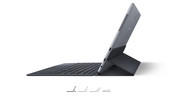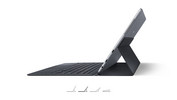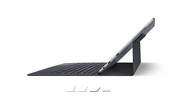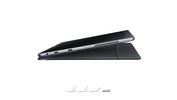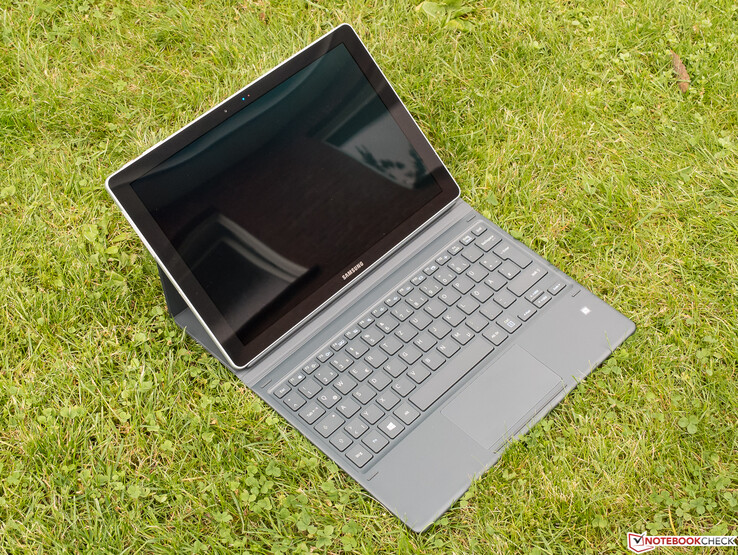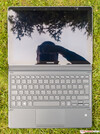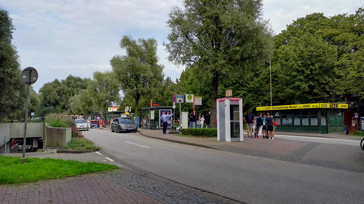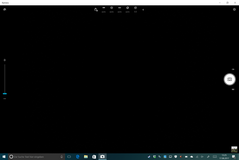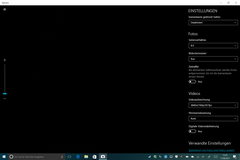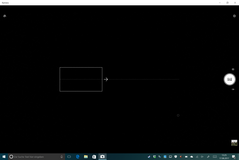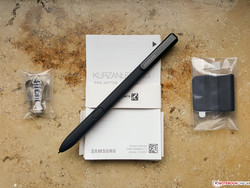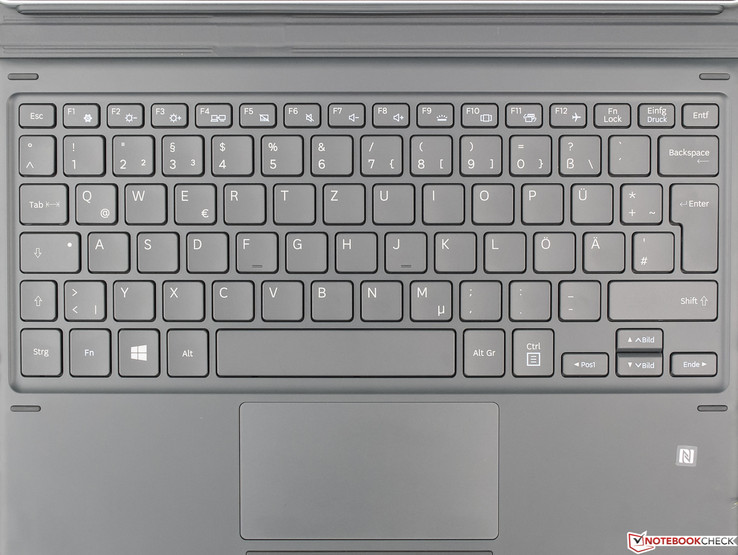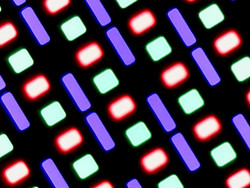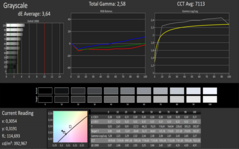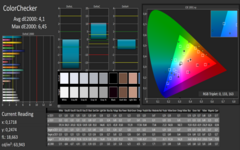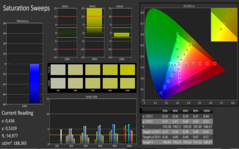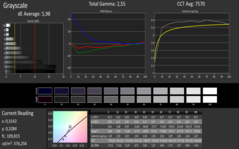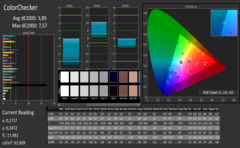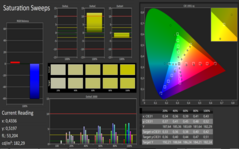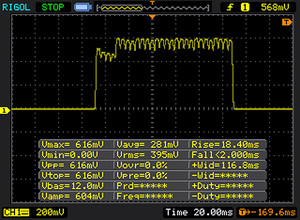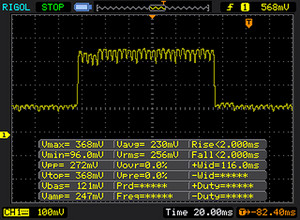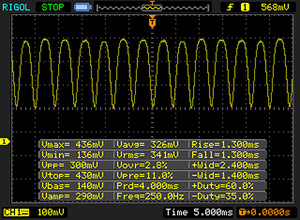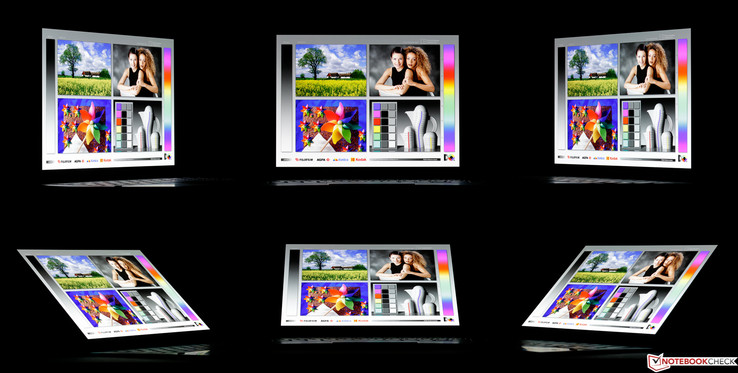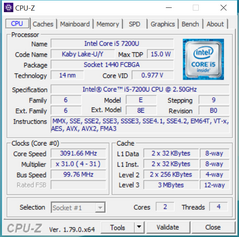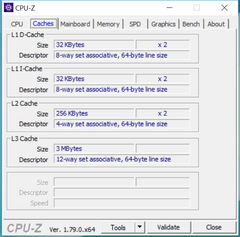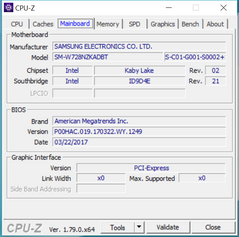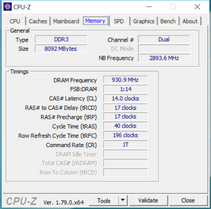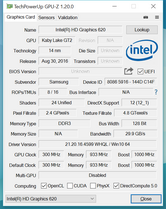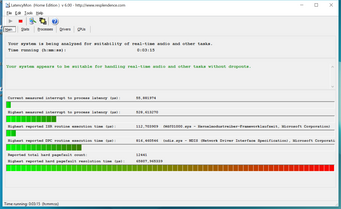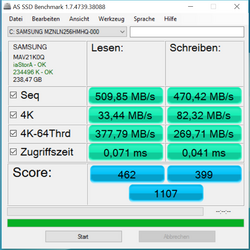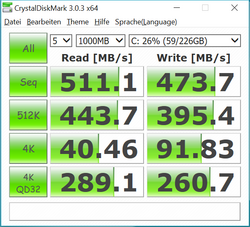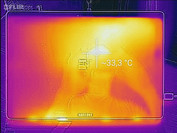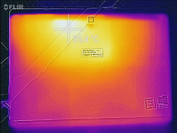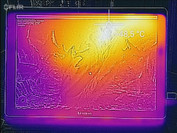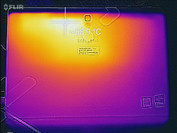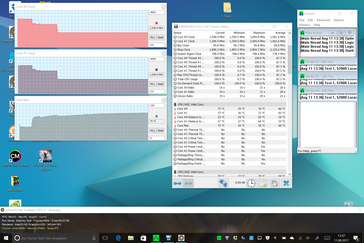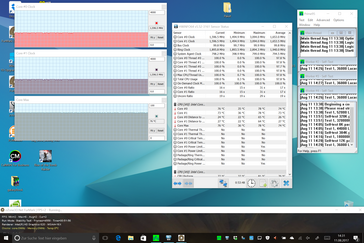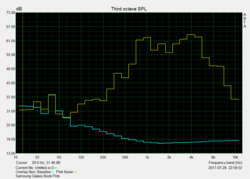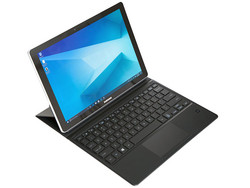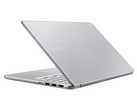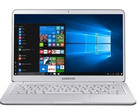Samsung Galaxy Book 12 LTE Convertible Review

For the original German review, click here.
Samsung's new Galaxy Book 12 LTE is the successor of the Galaxy Tab Pro S and seems to be the beginning of a new series - at least that is what we gathered from its name. It combines the advantages of a tablet with those of a subnotebook and is designed to be an ultra-portable office device with an efficient ULV dual-core CPU, 8 GB of RAM and an SSD. With this configuration, it should even manage more demanding software such as Adobe Photoshop and multitasking - its only real weak point is gaming. Samsung has a version without LTE and with Windows 10 Home available as well - our test unit with LTE comes with Windows 10 Pro.
The tablet offers only 2 USB 3.1 Gen1 Type-C ports and an audio jack. Security is taken care of by a TPM 2.0 chip and the device has Wi-Fi, UMTS and LTE. We have defined the device as a convertible and the Galaxy Book seems to be the only device in this segment that has a Super-AMOLED screen. The screen is in the trendy 3:2 format and has a resolution of 2160x1440 pixels.
The scope of delivery includes the keyboard cover and an S-Pen. The competitors Microsoft and Apple (iPad Pro) make you buy these accessories separately. Talking of competition: We have chosen four 12-inch convertibles with connecting keyboard and similar configurations (although the Lenovo IdeaPad Miix and the Acer Switch 5 cost a few hundred Dollars less) to be our comparison devices for this review, to help you with your decision. These are the devices we have chosen:
Case
Tablet
The tablet has a matte silver, seemingly robust unibody back that is apparently made of metal and curves up at the sides to frame the black bezels at the front. The Samsung logo and main camera are worked into the unibody back. The bezels are not particularly narrow (screen-to-body ratio), but at least they mean that you can easily hold the device with one hand without touching the screen by accident. There are no sharp edges and the on/off button and volume rocker are firmly in place with perfectly adjusted pressure points. They are positioned at the top of the device, together with the stereo microphones, while the two speakers are positioned at the top on either side.
Considering the high price, our expectations of quality and workmanship were rather high. But they have still been topped. The tablet is as hard as a log and both the front and back are pressure resistant. No matter what we did to it, the Galaxy Book 12 emitted no sound. We found no mistakes in the workmanship - even under the magnifying glass.
Keyboard cover
The dark gray/anthracite keyboard cover with its robust and textured surfaces gave us a rather high-quality impression as well. The tablet connects to the keyboard easily and is held in position by magnets. The well thought-out folding mechanism enables the tablet to be positioned at different angles, as you can see from the Samsung images below. Unfortunately, the keyboard lies flat and cannot be positioned ergonomically. The case is slightly curved upwards in the center and gives way under pressure. Unlike a notebook, the Galaxy Book requires a flat, stable surface to stand on. We will talk about the keyboard some more in the section about input devices.
The weight of the Galaxy Book 12 tablet alone is 754 g (~26.6 oz) and 1180 g (~41.6 oz) together with the keyboard cover. The Acer Switch 5, the MS Surface Pro and our test unit all have similar dimensions and weight, with the Acer Switch being the heaviest at 1.3 kg (~45.8 oz), and the MS Surface Pro being the lightest at 1.1 kg (~38.8). All other convertibles in the test weigh about 1.2 kg (~42.3 oz). The Lenovo IdeaPad Miix and the Dell Latitude 12 are both about one centimeter (~0.39 in) thicker than the other three candidates. Our Galaxy Book 12 is the slimmest of the devices with 7.4 mm (~0.29 in) (tablet only).
Connectivity
Ports
The only ports that the Galaxy Book has to offer are two USB 3.1 Gen 1 Type-C ports and one audio jack (3.5 mm). They are all positioned at the bottom right side of the tablet. On the left you can find the combined Nano-SIM/microSD slot while the bottom of the tablet is reserved for the connection to the keyboard cover. One of the USB ports supports DisplayPort, so you can connect an external screen; the device does not have Intel Wireless Display.
Cameras
The device is equipped with two cameras with CMOS sensors; the main (back) camera has 13 MP resolution and records videos in UHD with up to 30 FPS while the front camera can produce 5-MP images and Full HD videos, also with 30 FPS. The cameras record in 4:3 format, which can be changed to 16:9 if you accept lower resolution. Take a look at the screenshots below to see which functions and manual settings the cameras offer. You will also find the two sample images taken with the main camera that we used for our analysis.
Exposure is evenly distributed and there is very little noise (in daylight), although the muddiness of similar colors (leaves, grass, asphalt) suggests that the camera does some post-processing or noise suppression. The dynamics are not great, but here HDR mode can help. Without that, the sky would have appeared burned-out on the photos. Unfortunately, the HDR mode has some challenges with ghosting, as you can see from the leaves of the tree on the top right of the second photo. Overall, the quality of the photos is what we would nowadays expect from a $200 smartphone.
The front webcam takes almost identical images, but with lower resolution. Most functions and settings are also available for this camera, which makes it a very well-equipped camera (for a webcam!) with great image quality, although this does decrease considerably in bad lighting.
Communication
The Samsung Galaxy Book 12 LTE's wireless communication is taken care of by a Qualcomm Atheros module with a maximum gross data transfer rate of 867 MBit/s (MIMO 2x2). It supports all the usual standards including IEEE 802.11ac, which is located on the less-used 5 GHz band, and has integrated Bluetooth, version 4.1. If you take the overhead into consideration, the transfer rates that we measured at a distance of one meter (~3.2 ft) to our standard router, Linksys EA8500, are excellent and let the Galaxy Book take the lead in our comparison table.
Our test unit also supports UMTS/LTE, so that you need not go without internet even when there is no Wi-Fi around. Here is a list of the supported radio standards:
UMTS (3G): B1 (2100), B2 (1900), B5 (850), B8 (900)
4G FDD LTE: B1 (2100), B3 (1800), B5 (850), B7 (2600), B8 (900), B17 (700), B20 (800)
The device is equipped with a GPS/GLONASS receiver for positioning and navigation.
Security
Our test unit is equipped with a current Trusted Platform Module version 2.0, but lacks a fingerprint sensor. As Windows 10 Pro is pre-installed, you can also use BitLocker for disk encryption.
Accessories
Apart from the keyboard cover and power supply, our test unit also came with a battery-free S-Pen. This pen weighs about 10 g (~0.35 oz) and can differentiate between 4096 levels of pressure. It supports the S-Pen commands known from Android (see screenshot). The other accessories displayed in the center image seem to be a stand and replacement tips for the S-Pen and there is a tool for the SIM/microSD slot hidden behind the QuickStart and warranty information. We would have liked to have seen an adapter with USB, HDMI etc., but this has to be purchased separately.
Maintenance
As the case can only be opened with special tools, users cannot perform any maintenance work - not even changing the battery.
Warranty
The device comes with a 24-month warranty. Please see our Guarantees, Return policies and Warranties FAQ for country-specific information.
Input Devices
Keyboard
The three-level backlit keyboard of the Samsung Galaxy Book 12 LTE is only about one centimeter (~0.39 in) narrower than a standard desktop keyboard. The size and distance of the slightly concave keys are almost standard as well, as is the layout. The letters on the keys are easily legible and the keys have short travel, a strong pressure point and hard stops, which, subjectively, is very comfortable.
The keyboard is not really suitable for noise-sensitive surroundings as the keys do attract some attention. As mentioned above, the keyboard cover is curved upward in the center and can give way when pressing the keys in that area. However, we have already seen a lot worse on "real" laptops, so this is nothing to be ashamed of.
Touchpad
The ClickPad is rather small and has no separate mouse keys. It worked very well during testing: The smooth surface has good gliding qualities and responds quickly, precisely and reliably to inputs with up to four fingers and can trace quick movements without difficulty. Drag-&-Drop with double-tap works perfectly and gestures can be configured via the Windows 10 settings.
The integrated mouse keys have a firm pressure point, but the keyboard cover gives way noticeably when it is pressed. Apart from its size, we noticed no difference compared to good touchpads on conventional laptops.
Touchscreen
The touchscreen registers up to ten fingers at once and responds quickly and reliably. Dry fingers glide easily, but it becomes more difficult when they are moist. The device responded well and precisely to inputs with the S-Pen.
Display
Samsung is known as the pioneer and the largest manufacturer of AMOLED displays and it has equipped the Galaxy Book 12 with this technology. Unlike LC displays, OLED displays have light-emitting diodes that can be turned off completely to display the color black. Theoretically, this means that they have a black value of 0 cd/m², which would mean an infinitive contrast, independent of the maximum brightness.
Further characteristics of an OLED screen are their low power consumption when displaying dark content and relatively fast aging at high brightness levels. In order to counteract this, the screen is automatically dimmed all the way down after 5 minutes at the latest. This "feature" cannot be turned off, but luckily is deactivated automatically while watching videos.
The luminosity can easily keep up with the other comparison devices with an average of 278 cd/m² and maximum brightness of 396 cd/m². However, top smartphones such as the Samsung Galaxy S8 or the extremely bright Dell Latitude 12 are in another league. The resolution of 2160x1440 pixels on 12 inches in 3:2 format results in a high pixel density of 216 PPI. The image is very sharp and does not seem pixelated even from close up. As usual for touchscreens, the display is glossy. Brightness distribution is above average at 91% and clouding and screen bleeding are not an issue for OLED displays.
| |||||||||||||||||||||||||
Brightness Distribution: 91 %
Center on Battery: 376 cd/m²
Contrast: 12533:1 (Black: 0.03 cd/m²)
ΔE ColorChecker Calman: 4.1 | ∀{0.5-29.43 Ø4.77}
ΔE Greyscale Calman: 3.64 | ∀{0.09-98 Ø5}
93% sRGB (Argyll 1.6.3 3D)
74% AdobeRGB 1998 (Argyll 1.6.3 3D)
83.1% AdobeRGB 1998 (Argyll 3D)
92.8% sRGB (Argyll 3D)
77.3% Display P3 (Argyll 3D)
Gamma: 2.58
CCT: 7113 K
| Samsung Galaxy Book 12 SM-W728 Samsung SDCA029, , 2160x1440, 12" | Microsoft Surface Pro (2017) i5 LG Display LP123WQ112604, , 2736x1824, 12.3" | Dell Latitude 12 5285 2-in-1 BOE06DC, , 1920x1280, 12.3" | Acer Switch 5 SW512-52-5819 WST KL.1200w.004, , 2160x1440, 12" | Lenovo Ideapad Miix 720-12IKB AUO B120YAN01 / AUO106F, , 2880x1920, 12" | |
|---|---|---|---|---|---|
| Display | -8% | -13% | -19% | -13% | |
| Display P3 Coverage (%) | 77.3 | 67.6 -13% | 62.8 -19% | 58.8 -24% | 65.2 -16% |
| sRGB Coverage (%) | 92.8 | 99 7% | 94 1% | 87.5 -6% | 91 -2% |
| AdobeRGB 1998 Coverage (%) | 83.1 | 69.1 -17% | 64.7 -22% | 60.6 -27% | 66.1 -20% |
| Response Times | -498% | -507% | -428% | -523% | |
| Response Time Grey 50% / Grey 80% * (ms) | 4 ? | 42 ? -950% | 42.4 ? -960% | 37 ? -825% | 45 ? -1025% |
| Response Time Black / White * (ms) | 20 ? | 29 ? -45% | 30.8 ? -54% | 26 ? -30% | 24 ? -20% |
| PWM Frequency (Hz) | 250 ? | 21000 | 210.1 ? | ||
| Screen | -90% | -141% | -176% | -117% | |
| Brightness middle (cd/m²) | 376 | 417 11% | 523.2 39% | 369 -2% | 406 8% |
| Brightness (cd/m²) | 378 | 401 6% | 522 38% | 331 -12% | 396 5% |
| Brightness Distribution (%) | 91 | 88 -3% | 88 -3% | 75 -18% | 88 -3% |
| Black Level * (cd/m²) | 0.03 | 0.29 -867% | 0.42 -1300% | 0.46 -1433% | 0.3 -900% |
| Contrast (:1) | 12533 | 1438 -89% | 1246 -90% | 802 -94% | 1353 -89% |
| Colorchecker dE 2000 * | 4.1 | 3.63 11% | 4 2% | 5.52 -35% | 5.28 -29% |
| Colorchecker dE 2000 max. * | 6.45 | 6.74 -4% | 8.6 -33% | 9.29 -44% | 9.83 -52% |
| Greyscale dE 2000 * | 3.64 | 2.18 40% | 5.5 -51% | 6.95 -91% | 6.71 -84% |
| Gamma | 2.58 85% | 3.09 71% | 2.16 102% | 2.58 85% | 2.29 96% |
| CCT | 7113 91% | 6767 96% | 7546 86% | 7009 93% | 6532 100% |
| Color Space (Percent of AdobeRGB 1998) (%) | 74 | 63 -15% | 64.86 -12% | 56 -24% | 59 -20% |
| Color Space (Percent of sRGB) (%) | 93 | 99 6% | 93.97 1% | 88 -5% | 91 -2% |
| Total Average (Program / Settings) | -199% /
-128% | -220% /
-164% | -208% /
-178% | -218% /
-150% |
* ... smaller is better
As we measured remaining brightness of 0.03 cd/m² in the black value, we calculated a contrast of 12553:1. None of the comparison devices can keep up with this result, although they all have very good contrast values (except for the Acer Switch 5) - but then they have "only" got conventional LCD panels.
Good color accuracy is vital for professional image processing. This is defined by Delta E values below 3. Unlike the Lenovo IdeaPad Miix and the Acer Switch 3, the Samsung Galaxy Book 13 LTE is already quite close to this value ex-works. The Dell Latitude 12 also has a good result here. However, the Delta E gray scales deteriorated to 6 after calibration and profiling, while the ColorChecker results improved only minimally. You can download the color profile we used from the box above - although we would not recommend using it in this case.
Finally, we took a look at the color space coverage - another important factor for users who do image processing. Our test unit misses full coverage of the smaller sRGB color space by 7%, while the Surface Pro (2017) is the only device to reach almost 100%.
Even with an overcast sky it is important to position yourself well when working outdoors, so that the ever-present reflections are as low as possible. The screen must not be directed at bright surfaces such as the sky – as you can see from the left photo. Even in an almost ideal position with our back to the front door (right), our reflections can still be guessed at, but the screen is legible.
Display Response Times
| ↔ Response Time Black to White | ||
|---|---|---|
| 20 ms ... rise ↗ and fall ↘ combined | ↗ 18 ms rise | |
| ↘ 2 ms fall | ||
| The screen shows good response rates in our tests, but may be too slow for competitive gamers. In comparison, all tested devices range from 0.1 (minimum) to 240 (maximum) ms. » 42 % of all devices are better. This means that the measured response time is similar to the average of all tested devices (20.2 ms). | ||
| ↔ Response Time 50% Grey to 80% Grey | ||
| 4 ms ... rise ↗ and fall ↘ combined | ↗ 2 ms rise | |
| ↘ 2 ms fall | ||
| The screen shows very fast response rates in our tests and should be very well suited for fast-paced gaming. In comparison, all tested devices range from 0.165 (minimum) to 636 (maximum) ms. » 14 % of all devices are better. This means that the measured response time is better than the average of all tested devices (31.6 ms). | ||
Screen Flickering / PWM (Pulse-Width Modulation)
| Screen flickering / PWM detected | 250 Hz | ≤ 100 % brightness setting | |
The display backlight flickers at 250 Hz (worst case, e.g., utilizing PWM) Flickering detected at a brightness setting of 100 % and below. There should be no flickering or PWM above this brightness setting. The frequency of 250 Hz is relatively low, so sensitive users will likely notice flickering and experience eyestrain at the stated brightness setting and below. In comparison: 53 % of all tested devices do not use PWM to dim the display. If PWM was detected, an average of 8084 (minimum: 5 - maximum: 343500) Hz was measured. | |||
Can the display's viewing-angle stability keep up with that of a good IPS panel? Yes, it can. Wider viewing angles do cause the usual decrease in contrast and brightness, but the difference is very small while colors are displayed much the same. Only at very flat angles can you see the green and purple coloring, typical for OLED screens.
Performance
Processor
Samsung has put its bet on the bread-and-butter i5 7200U (2x 2.5 - 3.1 GHz, Hyperthreading, TDP 15 W) of the current Kaby Lake generation. This CPU is nominally the slowest processor of all comparison devices, which our diagram below can confirm. Only the Lenovo with its i7-7500U (2x 2.7 - 3.5 GHz) seems to already start suffering from throttling in this scenario. The performance of our test unit's processor lies in the bottom range of what you can expect from an i5-7200U - although the winner in our database is ahead by only 4%.
As you can see from the diagram of the Cinebench Multicore loop, the score plummets by 40 points after only two rounds, although the processor does recover again after a few rounds and settles down at around 300. This is because the core temperatures reach 80 °C (~176 °F) after three minutes and the CPU can only run at the base clock rate - 100 to 200 MHz. A rerun in battery mode resulted in 325 points.
System Performance
The results of the PCMark 8 show a lot of inconsistencies. We cannot explain why the convertibles seem to take it in turn to have the best results and a detailed analysis would be beyond the scope of this review. Subjectively, the system operated smoothly and the operating system and programs all started quickly.
| PCMark 8 Home Score Accelerated v2 | 3538 points | |
| PCMark 8 Work Score Accelerated v2 | 4291 points | |
Help | ||
Storage Devices
Samsung has equipped our test unit with its own SATA-III SSD, which has typical benchmark results for this interface. Sequential reading and writing rates are around the top limit of this interface of about 500 MB/s. The rates that are important for starting programs and the OS are reading smaller blocks of data that are widely distributed (4K Read). Here, the AS SSD measured an acceptable rate of about 33 MB/s while the results of the CrystalDiskMark 3.0 (40 MB/s) can even be considered good.
The table below shows that the competitor's SSDs are not limited by SATA III - they had PCIe interfaces. The Samsung PM961 SSD in the Microsoft Convertible, as swift as an arrow, is clearly ahead of its competition. Our Galaxy Book 12 is often in last place.
| Samsung Galaxy Book 12 SM-W728 Samsung SSD PM871a MZNLN256HMHQ | Microsoft Surface Pro (2017) i5 Samsung PM971 KUS030202M | Dell Latitude 12 5285 2-in-1 Samsung PM961 MZVLW256HEHP | Acer Switch 5 SW512-52-5819 Intel SSD 600p SSDPEKKW512G7 | Lenovo Ideapad Miix 720-12IKB Samsung SSD PM961 1TB M.2 PCIe 3.0 x4 NVMe (MZVLW1T0) | |
|---|---|---|---|---|---|
| CrystalDiskMark 3.0 | 28% | 47% | 46% | 162% | |
| Read Seq (MB/s) | 511 | 723 41% | 1294 153% | 1066 109% | 2408 371% |
| Write Seq (MB/s) | 473.7 | 853 80% | 865 83% | 593 25% | 1702 259% |
| Read 512 (MB/s) | 443.7 | 225 -49% | 406 -8% | 653 47% | 1301 193% |
| Write 512 (MB/s) | 395.4 | 445 13% | 589 49% | 535 35% | 1288 226% |
| Read 4k (MB/s) | 40.46 | 46 14% | 31.75 -22% | 35.92 -11% | 53.6 32% |
| Write 4k (MB/s) | 91.9 | 125 36% | 72.2 -21% | 128.3 40% | 162.2 76% |
| Read 4k QD32 (MB/s) | 289.1 | 423 46% | 493.3 71% | 460.6 59% | 504 74% |
| Write 4k QD32 (MB/s) | 260.7 | 373 43% | 434.5 67% | 425.4 63% | 420.8 61% |
Graphics
Intel's HD Graphics is an integrated graphics card without dedicated memory. It is very energy-efficient, but has low 3D performance, even after many generations. CPU and GPU have to share the RAM and often tight TDP of 15 watts. The Intel HD Graphics 620 in our test unit has a turbo limit of 1000 MHz and can hardly benefit from the dual-channel RAM.
In a comparison of all 620 GPUs in our database, our test unit's performance is a good average. The Galaxy Book lay 4% above the average in the PCMark 11 (Graphics Score) and 20% behind the leader. The 3DMark 11 total score does not drop on battery.
| 3DMark 11 - 1280x720 Performance GPU | |
| Acer Switch 5 SW512-52-5819 | |
| Dell Latitude 12 5285 2-in-1 | |
| Samsung Galaxy Book 12 SM-W728 | |
| Lenovo Ideapad Miix 720-12IKB | |
| 3DMark | |
| 1280x720 Cloud Gate Standard Graphics | |
| Dell Latitude 12 5285 2-in-1 | |
| Acer Switch 5 SW512-52-5819 | |
| Samsung Galaxy Book 12 SM-W728 | |
| Lenovo Ideapad Miix 720-12IKB | |
| Microsoft Surface Pro (2017) i5 | |
| 1920x1080 Fire Strike Graphics | |
| Dell Latitude 12 5285 2-in-1 | |
| Acer Switch 5 SW512-52-5819 | |
| Samsung Galaxy Book 12 SM-W728 | |
| Microsoft Surface Pro (2017) i5 | |
| 3DMark 11 Performance | 1683 points | |
| 3DMark Cloud Gate Standard Score | 6149 points | |
| 3DMark Fire Strike Score | 888 points | |
Help | ||
Gaming Performance
If you are hoping to do some gaming with the Galaxy Book 12, you will have to content yourself with very old and/or graphically undemanding 3D games and isometric games such as "Diabolo III", "StarCraft II" or "FIFA", which usually run smoothly at medium settings. Other notebooks with the Intel HD 620 at medium settings with 1366x768 pixels can play the not particularly fancy, but up-to-date "Farming Simulator 17" with a few frames more than our Galaxy Book. It seems that the first run (min.) already caused thermal throttling in our test unit.
| low | med. | high | ultra | |
|---|---|---|---|---|
| The Witcher 3 (2015) | 14.9 | |||
| Rise of the Tomb Raider (2016) | 19.8 | |||
| Farming Simulator 17 (2016) | 58.5 | 24.1 |
Emissions
System Noise
The tablet has a cooling fan that turns on under load. If you sit at a normal distance to the device, you will only discern the cooling fan from ambient noise in very quiet surroundings. We noticed no change in volume or rotation speeds at different levels of load.
Noise level
| Idle |
| / 30.3 / dB(A) |
| Load |
| 31.7 / 31.7 dB(A) |
 | ||
30 dB silent 40 dB(A) audible 50 dB(A) loud |
||
min: | ||
Temperature
If you put the Samsung Galaxy Book 12 LTE under load for a prolonged period of time and then pick it up, you will feel temperatures of up to 56 °C (~132.8 °F) around the main camera, which can become uncomfortable. Subjectively, the high surface temperatures are to be the biggest of the few weaknesses of the test unit. However, the device does not even reach body temperature when using Office software, watching videos or surfing.
After activating the stress test (Prime95 + FurMark) the CPU frequencies dropped to the base frequency of 2.5 GHz immediately. After two more minutes, there were only 1.6 GHz left, which suggests significant throttling in this unrealistic scenario. However, this is typical behavior for ULV processors with integrated graphics from Intel.
(-) The maximum temperature on the upper side is 52.5 °C / 127 F, compared to the average of 35.4 °C / 96 F, ranging from 19.6 to 60 °C for the class Convertible.
(-) The bottom heats up to a maximum of 56.3 °C / 133 F, compared to the average of 36.8 °C / 98 F
(+) In idle usage, the average temperature for the upper side is 29.6 °C / 85 F, compared to the device average of 30.3 °C / 87 F.
(+) The palmrests and touchpad are reaching skin temperature as a maximum (33.6 °C / 92.5 F) and are therefore not hot.
(-) The average temperature of the palmrest area of similar devices was 27.9 °C / 82.2 F (-5.7 °C / -10.3 F).
Speakers
We did not have high expectations of the small speakers - and there were no real surprises. The maximum volume was just loud enough to fill a medium-sized room. Clearly there is a lot of compression, as mid- and high-frequency sounds sound rather meagre, forced and unnatural - depending on the track - and there are some volume fluctuations at high levels.
We did not notice too much distortion, but the sound system did tend to mix the sounds of loud instruments together. Luckily, some dynamics remained despite the lack of real bass. Speech in films sounds clear and a lot more natural than most songs.
Samsung Galaxy Book 12 SM-W728 audio analysis
(-) | not very loud speakers (63.5 dB)
Bass 100 - 315 Hz
(-) | nearly no bass - on average 15% lower than median
(±) | linearity of bass is average (7.1% delta to prev. frequency)
Mids 400 - 2000 Hz
(±) | higher mids - on average 6.7% higher than median
(±) | linearity of mids is average (14.6% delta to prev. frequency)
Highs 2 - 16 kHz
(±) | higher highs - on average 7.1% higher than median
(±) | linearity of highs is average (9.4% delta to prev. frequency)
Overall 100 - 16.000 Hz
(-) | overall sound is not linear (32.6% difference to median)
Compared to same class
» 91% of all tested devices in this class were better, 3% similar, 6% worse
» The best had a delta of 6%, average was 20%, worst was 57%
Compared to all devices tested
» 91% of all tested devices were better, 2% similar, 7% worse
» The best had a delta of 4%, average was 24%, worst was 134%
Microsoft Surface Pro (2017) i5 audio analysis
(-) | not very loud speakers (68 dB)
Bass 100 - 315 Hz
(±) | reduced bass - on average 9.7% lower than median
(±) | linearity of bass is average (7% delta to prev. frequency)
Mids 400 - 2000 Hz
(+) | balanced mids - only 4.6% away from median
(+) | mids are linear (6.3% delta to prev. frequency)
Highs 2 - 16 kHz
(+) | balanced highs - only 2.1% away from median
(+) | highs are linear (5.2% delta to prev. frequency)
Overall 100 - 16.000 Hz
(±) | linearity of overall sound is average (18.2% difference to median)
Compared to same class
» 39% of all tested devices in this class were better, 7% similar, 54% worse
» The best had a delta of 6%, average was 20%, worst was 57%
Compared to all devices tested
» 38% of all tested devices were better, 8% similar, 54% worse
» The best had a delta of 4%, average was 24%, worst was 134%
Dell Latitude 12 5285 2-in-1 audio analysis
(±) | speaker loudness is average but good (72.4 dB)
Bass 100 - 315 Hz
(-) | nearly no bass - on average 16.3% lower than median
(±) | linearity of bass is average (11% delta to prev. frequency)
Mids 400 - 2000 Hz
(+) | balanced mids - only 4.3% away from median
(±) | linearity of mids is average (11.3% delta to prev. frequency)
Highs 2 - 16 kHz
(+) | balanced highs - only 2.6% away from median
(±) | linearity of highs is average (8.2% delta to prev. frequency)
Overall 100 - 16.000 Hz
(±) | linearity of overall sound is average (23.5% difference to median)
Compared to same class
» 71% of all tested devices in this class were better, 5% similar, 25% worse
» The best had a delta of 6%, average was 20%, worst was 57%
Compared to all devices tested
» 70% of all tested devices were better, 6% similar, 24% worse
» The best had a delta of 4%, average was 24%, worst was 134%
Acer Switch 5 SW512-52-5819 audio analysis
(-) | not very loud speakers (69 dB)
Bass 100 - 315 Hz
(-) | nearly no bass - on average 26.3% lower than median
(+) | bass is linear (6.6% delta to prev. frequency)
Mids 400 - 2000 Hz
(±) | reduced mids - on average 6.8% lower than median
(±) | linearity of mids is average (10.4% delta to prev. frequency)
Highs 2 - 16 kHz
(+) | balanced highs - only 2.8% away from median
(+) | highs are linear (3.8% delta to prev. frequency)
Overall 100 - 16.000 Hz
(±) | linearity of overall sound is average (26.7% difference to median)
Compared to same class
» 83% of all tested devices in this class were better, 3% similar, 15% worse
» The best had a delta of 6%, average was 20%, worst was 57%
Compared to all devices tested
» 81% of all tested devices were better, 4% similar, 15% worse
» The best had a delta of 4%, average was 24%, worst was 134%
Lenovo Ideapad Miix 720-12IKB audio analysis
(-) | not very loud speakers (64 dB)
Bass 100 - 315 Hz
(±) | reduced bass - on average 9.9% lower than median
(-) | bass is not linear (16.2% delta to prev. frequency)
Mids 400 - 2000 Hz
(±) | higher mids - on average 7.3% higher than median
(±) | linearity of mids is average (13.3% delta to prev. frequency)
Highs 2 - 16 kHz
(+) | balanced highs - only 3.3% away from median
(±) | linearity of highs is average (12.2% delta to prev. frequency)
Overall 100 - 16.000 Hz
(±) | linearity of overall sound is average (25.1% difference to median)
Compared to same class
» 76% of all tested devices in this class were better, 7% similar, 18% worse
» The best had a delta of 6%, average was 20%, worst was 57%
Compared to all devices tested
» 76% of all tested devices were better, 5% similar, 19% worse
» The best had a delta of 4%, average was 24%, worst was 134%
Frequency diagram in comparison (checkboxes can be turned on/off!)
Energy Management
Power Consumption
As our comparison devices are very comparable (12-inch, ULV dual core, SSD) we will stick to these. The Samsung Galaxy Book 12 LTE consumes a little more than usual in the three idle states, but the device appears a lot more energy-efficient under load. Only the MS Surface Pro consumes less - although this is only due to its massive throttling. The reason the other devices from Dell, Acer and Lenovo consume so much more is probably due to the higher CPU frequencies of their i7 processors. But we must not forget that the consumption of OLED displays depends on the displayed content.
The power supply has 25 watts and is not quite large enough considering the maximum consumption of up to 28 watts.
| Off / Standby | |
| Idle | |
| Load |
|
Key:
min: | |
| Samsung Galaxy Book 12 SM-W728 i5-7200U, HD Graphics 620, Samsung SSD PM871a MZNLN256HMHQ, Super AMOLED, 2160x1440, 12" | Microsoft Surface Pro (2017) i5 i5-7300U, HD Graphics 620, Samsung PM971 KUS030202M, IPS, 2736x1824, 12.3" | Dell Latitude 12 5285 2-in-1 i7-7600U, HD Graphics 620, Samsung PM961 MZVLW256HEHP, IPS, 1920x1280, 12.3" | Acer Switch 5 SW512-52-5819 i7-7500U, HD Graphics 620, Intel SSD 600p SSDPEKKW512G7, IPS, 2160x1440, 12" | Lenovo Ideapad Miix 720-12IKB i7-7500U, HD Graphics 620, Samsung SSD PM961 1TB M.2 PCIe 3.0 x4 NVMe (MZVLW1T0), IPS, 2880x1920, 12" | |
|---|---|---|---|---|---|
| Power Consumption | 14% | 8% | 8% | 9% | |
| Idle Minimum * (Watt) | 3.9 | 3.6 8% | 2.85 27% | 3.86 1% | 3.5 10% |
| Idle Average * (Watt) | 9 | 8.1 10% | 6.76 25% | 6.4 29% | 7.2 20% |
| Idle Maximum * (Watt) | 11.9 | 8.7 27% | 6.91 42% | 7.17 40% | 7.9 34% |
| Load Average * (Watt) | 27.3 | 25.5 7% | 32.88 -20% | 30.5 -12% | 29.6 -8% |
| Load Maximum * (Watt) | 27.9 | 23.5 16% | 37.41 -34% | 32.4 -16% | 30.8 -10% |
* ... smaller is better
Battery Runtime
Due to the forced dimming of the screen as we discussed in the display section, we were only able to do the idle and H.264 battery runtime tests. As the comparison devices were not tested for H.264 runtimes, we will have to make do with comparing the idle battery runtimes. However, the Galaxy Book 12 is so dark at minimum brightness that it becomes hard to read the screen.
The test unit, the Dell Latitude and the Lenovo IdeaPad all have almost identical battery capacities. The Dell can keep up with the Samsung's runtime, but the Lenovo turns off about 5 hours before the other two. The battery of our Microsoft Surface was about 15% larger, but lasted only 2% longer than our test unit. The higher consumption seems not to have impacted our device's battery runtime.
| Samsung Galaxy Book 12 SM-W728 i5-7200U, HD Graphics 620, 39 Wh | Microsoft Surface Pro (2017) i5 i5-7300U, HD Graphics 620, 45 Wh | Dell Latitude 12 5285 2-in-1 i7-7600U, HD Graphics 620, 42 Wh | Acer Switch 5 SW512-52-5819 i7-7500U, HD Graphics 620, Wh | Lenovo Ideapad Miix 720-12IKB i7-7500U, HD Graphics 620, 41 Wh | |
|---|---|---|---|---|---|
| Battery runtime | 2% | 4% | -31% | -31% | |
| Reader / Idle (h) | 17.2 | 17.6 2% | 17.9 4% | 11.9 -31% | 11.9 -31% |
| H.264 (h) | 6.8 | ||||
| WiFi v1.3 (h) | 12.4 | 8.1 | 5.9 | 5.8 | |
| Load (h) | 2.8 | 1.8 | 1.6 | 1.9 |
Verdict
Pros
Cons
Prospective buyers with enough petty cash can hardly go wrong with the Samsung Galaxy Book 12 LTE if they like the idea of a connecting keyboard and high portability. Apart from the meagre port selection, Samsung really has managed to combine the best of both worlds in one device.
S-Pen and keyboard cover are both included in the scope of delivery and perform just as well as the well-designed and perfectly-manufactured tablet.
Although the Super-AMOLED display is not perfect, it can be seen as a unique selling point of Samsung's new convertible with its great black value and high contrast. Our test unit was an LTE device and fulfilled all requirements for portability, including GPS/GLONASS, TPM, BitLocker on Windows 10 Pro and great battery runtime. Office and business users will be delighted with the flexible positioning and good input devices while the quality of the cameras means that they are more than a nice little extra.
The fact that Samsung has chosen a quiet cooling system and acceptable case temperatures over full performance under continuous load should not be noticeable as long as the device is used for its intended purpose - as an office device. Therefore, we would definitely recommend this device for purchase.
Samsung Galaxy Book 12 SM-W728
- 10/24/2019 v7 (old)
Sven Kloevekorn




